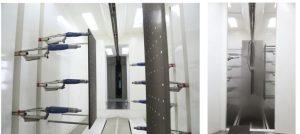Fully understanding MDF powder coating

Powder coating on metal surfaces is well established, very stable and has good level control. To understand why MDF powder coating and metal surface powder coatings are so different, it is necessary to understand the inherent properties of MDF. It is generally believed that the main difference between metal and MDF is electrical conductivity. This may be true in terms of absolute conductivity values; however, it is not the most important factor for MDF powder coatings
Typically, MDF powder coating with a surface resistance of 1010Ω and 1011Ω provide sufficient conductivity. Standard MDF at room temperature has a surface resistivity of about 1012Ω. By preheating MDF, adding a small amount of additives, or using MDF, or both, these can easily adjust the conductivity of MDF back to the desired range.
However, the bigger difference between metal and MDF is thermal conductivity. Table 1 shows the thermal conductivity of various materials. The thermal conductivity of MDF is only 0.07[W/(m•K)]. Aluminum powder coatings have a much lower thermal conductivity than aluminum and are the most commonly used substrates. This temperature distribution within the MDF substrate presents many difficulties for powder coatings
MDF is an asbestos blanket with the same low thermal conductivity as asbestos blanket, and is a material for fire fighting equipment and high heat-resistant gloves. Therefore, MDF takes a long time to heat up and cool down. During heating and cooling, the surface temperature and core temperature of the MDF will vary. The surface heating of a part of the MDF is very different from the surface temperature and edge temperature of other parts, and this phenomenon is not obvious when spraying aluminum.
In addition, in order to obtain high-quality powder coatings, we must carefully control various properties of MDF, such as surface finish, polishability, outgassing, resistance to cracking at a certain temperature, and some other properties. One of the key performance indicators of MDF is easily affected by the MDF manufacturing process and the internal bonding strength of MDF. This should be at a high level within the bond strength.
All in all, MDF should have heat resistance, electrical conductivity and good polishability. Fortunately, MDF manufacturers have been able to produce these types of panels. In fact, some MDF manufacturers have started to market MDF for powder coatings.
